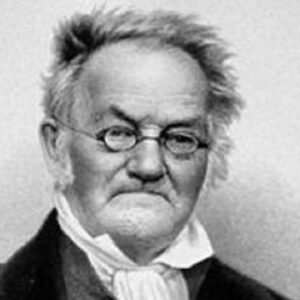Carl Ritter was a well-known German geographer who co-founded modern geography with Alexander von Humboldt. In 1820, he became a Geography Professor at the University of Berlin, bolstered by his strengths in history, theology, and natural sciences, and inspired by Johann Heinrich Pestalozzi and Johann Gottfried von Herder. Geography was an experimental discipline for him, thus he did a lot of fieldwork, observations, and study. For inspiration and guidance, he looked to Humboldt and his writings. Ritter, on the other hand, was a devout Christian who taught his students how God’s purpose was revealed in the harmony of man and nature. He gave a geographical interpretation of history, and his ideas influenced geographical studies in Germany long after he died. ‘Die Erdkunde im Verhältniss zur Natur und zur Geschichte des Menschen,’ his great achievement, was planned as a world geographical study but was left unfinished at the time of his death. His first volume, on Africa, was published in 1817 and gained him a coveted seat at the University of Berlin. He wrote other books later in life, mostly about Asia. The book included nearly 20,000 pages in 19 volumes, despite being incomplete.
Childhood and Adolescence
Carl Ritter was born on August 7, 1779, in Quedlinburg, Germany, to parents who had six children. His father, F. W. Ritter, was a well-known physician who served as the personal physician of Frederick the Great’s sister. His mother was a firm believer in the Pietist faith.
Ritter’s father passed away when he was still a tiny child. He was enrolled in the Schnepfenthal Salzmann School at the age of five, a school that emphasized physical characteristics such as a healthy body and good character.
He gradually came into contact with some of the period’s most prominent intellectuals. J.C.F. GutsMuths, a geographer, taught him about the relationship between man and his surroundings. He also developed and maintained an interest in innovative educational approaches, such as Johann Heinrich Pestalozzi’s.
Career of Carl Ritter
After graduating from high school, Bethmann Hollweg, a wealthy Frankfurt banker, employed Carl Ritter as a tutor for his two children and paid for his study at the University of Halle. This occurred in 1798, and he remained as tutor for the next fifteen years.
Meanwhile, in 1804, at the age of 25, he produced his first geographical work on Europe’s natural features.
He first met Humboldt in 1807 and was blown away by his resourcefulness in watching natural and human occurrences all around the world. He wrote a two-volume treatise on European geography in 1811.
He began studying geography, history, pedagogy, physics, chemistry, geology, and botany at the University of Gottingen in 1814. He was an astute observer who went on to become a geographer and an accomplished landscape artist.
In 1817, he completed and published the first book of his greatest work, ‘Die Erdkunde,’ which was meant to be a world geography. He was a staunch believer in God, and his writings frequently described God’s purpose coming to fruition on Earth.
In 1819, he was assigned to the first chair of Geography at the University of Berlin, and the following year, he became Professor of History at the University of Frankfurt. He was well-liked by his pupils, and his lectures were always well-attended.
He graduated from the University of Berlin with a doctorate in 1821 and was designated Professor Extraordinary in 1825. He worked and lectured at the University of Berlin for 39 years before dying.
His work reflects his active participation in important intellectual movements of the time, including the German Enlightenment, Romanticism, and the Biedermeier period. His work frequently sparked philosophical debates and conflicts.
Major Projects of Carl Ritter
From 1816 through 1859, Ritter worked on his most important work, ‘Die Erdkunde in Verhältniss zur Natur und zur Geschichte des Menschen’ (Geography in Relation to Nature and the History of Mankind).
‘Die Erdkunde’ not only described how the physical environment affects human activities, but it also established Geography as a legitimate discipline. Although it had 19 volumes, it was still unfinished at the time of his death and only covered Asia and Africa.
During his lifetime, many of his writings were published in the Berlin Geographical Society’s ‘Monatsberichte’ and the ‘Zeitschrift für allgemeine Erdkunde.’ After his death, his other works were published, including ‘Geschichte der Erdkunde und der Entdeckungen’ (1861), ‘Allgemeine Erdkunde’ (1862), and ‘Europa’ (1863).
Achievements and Awards
Ritter was a co-founder of modern geography alongside Alexander von Humboldt.
He was elected to the Prussian Academy of Sciences in 1822, and a corresponding member of the Société Asiatique de Paris two years later in 1824.
He founded the ‘Gesellschaft für Erdkunde zu Berlin’ in 1828. (Berlin Geographical Society).
He was named curator of Prussia’s Royal Cartographic Institute in 1856.
Personal History and Legacy
Ritter courted and married Lilli Kramer of Duderstadt while studying at the University of Gottingen.
In Germany, he was an anti-slavery and anti-racism campaigner. The British government tasked one of his students, explorer Heinrich Barth, with negotiating treaties in Africa to end the Trans-Saharan slave trade.
At the age of 80, he died in Berlin on September 28, 1859.
In 1865, a memorial was erected in his honor at the Bruehl’s entrance in Quedlinburg. In California, the Ritter Range is also named for him.
Estimated Net Worth
The estimated net worth of Carl Ritter is unknown.
Trivia
He acquired Greek and Latin so that he might understand more about the globe, as he was not a global wanderer like Humboldt.


